|

by Paul Perov
July
2004
from
Cosmogony and Pseudo-Science
Website
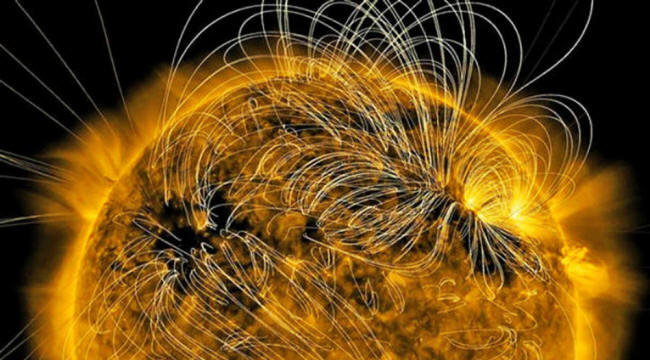
The Sun generates a
complex magnetic field to form the interplanetary magnetic field.
Although solar and terrestrial magnetic fields behave differently,
during solar minimum the Sun's field, like Earth's, resembles that
of an iron
bar
magnet, with great closed loops near the equator and open field
lines near the poles.
Scientists call such a field a "dipole."
The
Sun's dipolar field is about as strong as a refrigerator magnet, or
50 gauss (a unit of magnetic intensity).
Field strengths in sunspots are in the range 1000 - 4000 Gauss, with
the stronger fields in the larger sunspots; this is much larger than
the average 0.5 Gauss of the Earth's surface magnetic field.
Diffuse
magnetic fields of lesser strengths are also present all over the
solar surface, with moderately strong (~ 100 Gauss) fields most
often associated with plagues.
Instead of a dipole field, the sun has a field made up of large
numbers of localized flux elements spread throughout the outer
layers of its globe. Nevertheless there are usually large areas of
net polarity at the polar regions, with the north polarity being
opposite the south.
During the minimum phase of a cycle, most of the surface magnetic
fields form a pattern of mixed polarities.
The polar regions,
however, are covered by predominately unipolar fields that are of
opposite polarity in each hemisphere and extend to latitudes of
around 50 degrees.
With increasing activity, the mixed-polarity fields at lower
latitudes are replaced by active regions and at higher latitude by
the large-scale patterns of unipolar magnetic flux that develop as
the active region magnetic fields decay and disperse.
These large
scale magnetic flux patterns appear to be transported systematically
toward the poles by a random-walk dispersal mechanism, merdidional
motions, differential rotation.
The net effect of this process in the rise of the cycle and into the
maximum phase is a succession of large-scale patterns of magnetic
flux of both polarities extending from the activity belts to higher
latitudes.
Those of the same polarity augment the polar fields,
while those of opposite polarity cancel with and eventually reverse
the polar fields during the sunspot cycle maximum.
As cycle activity declines, the unipolar fields in the polar regions
increase in area and strength, while the large-scale unipolar fields
are replaced by the time of sunspot minimum with patterns of
mixed-polarity fields.
The magnetic field is primarily directed
outward from the Sun in one of its hemispheres, and inward in the
other. The thin layer between the different field directions is
described as the neutral current sheet (i.e. between the positive and
negative layers).
Since this dividing line between the outward and
inward field directions is not exactly on the solar equator, the
rotation of the Sun causes the current sheet to become "wavy", and
this waviness is carried out into interplanetary space by the solar
wind.
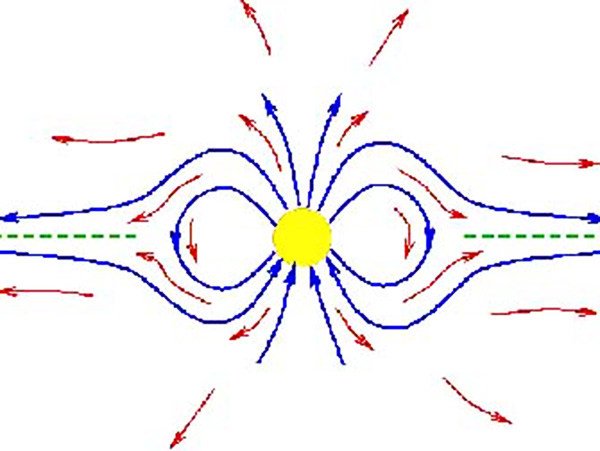
The Solar wind (red lines) leaves the sun radially
around its globe
and follows the magnetic lines
in an outward direction independent
of the field's direction.
The blue lines show the positive and
negative directions of the field.
The dashed green line is the
neutral sheet
The magnetic field
at the poles is substantially different from that at the Sun's
equator.
At the equator, the magnetic field lines generally do not
stray far from the surface. They come out from one point in the
surface and go back in again not far away, forming loops.
Sunspots
are found at the bases of really strong loops. At the poles,
however, the magnetic field lines go out to far distances away from
the Sun. If they go back again at all, it's far away from where they
came out.
Sunspots can't form under these conditions.
Field lines wave around in a chaotic way, but they follow the
expected spiral pattern when averaged out over a longer period.
The magnetic field in the heliosphere originates from a variety of
sources on the surface of the Sun, including sunspots and mature,
decaying, and decayed active regions.
The emergence of new active
regions together with the dispersal of flux from older active
regions causes the coronal magnetic field topology to continually
evolve, allowing previously closed-field regions to open into the heliosphere and previously open-field regions to close.
Such
evolution of the coronal field, together with the rotation of the
Sun, drive space weather through the continually changing conditions
of the solar wind and the magnetic field embedded within it.
Around cycle maximum, the interplanetary magnetic field (IMF) is
typically rooted in a dozen disjoint regions on the solar surface.
Whereas active regions are sometimes ignored as a source for the
IMF, the fraction of the IMF that connects directly to magnetic plage is found to reach up to 30-50% at cycle maximum, with even
direct connections between sunspots and the heliosphere.
If you go to the
SOHO website you can see daily images of the sunspots as in
various formats.
Magnetograms
are images of magnetic field polarity. They show regions of opposite
ploarity.
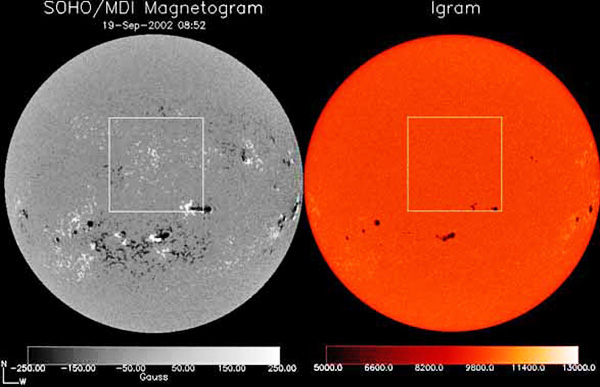
The magnetogram (above, left)
shows spots of positive and negative
fields
splashed all over the Sun all
as dots of black (negative) or
white (positive).
The Igram (right) shows the sunspots
as they are
seen on the photosphere.
Comparing them identifies the
sunspots in
the magnetogram.
Check the date
against the solar cycle chart (below).
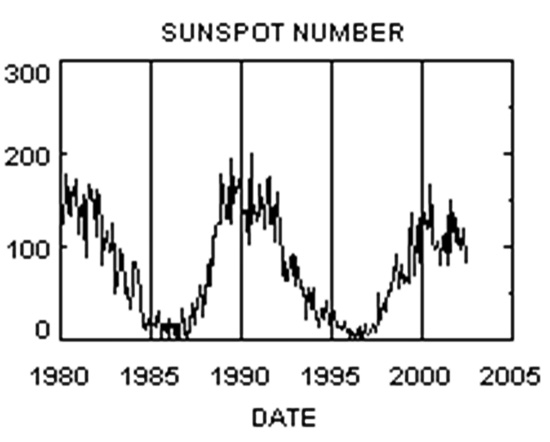
You can see we're passing the solar maximum, so the pattern of
sunspots along (but at an angle to) the equator was still visible in
September.
Go to the next 2 or 3 days (by going to the
SOHO website)
and see how the spots have moved, bearing in mind that it takes 25-
30 days for a revolution. Now go to images during a solar minimum.
The sunspots are infrequent at this phase of the cycle.
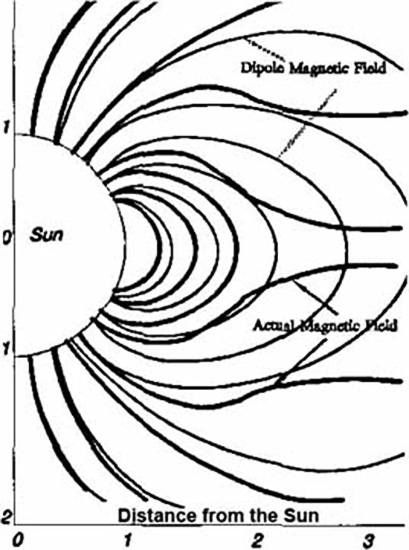
Right: A view of the field lines from above a pole of the sun.
Dipole field lines would join between the positive and negative
poles.
Here it can be seen that this only occurs at closer latitudes
to the equator
whereas the lines coming out from the poles extend
and curve to becomes like
a disk at the equator with a neutral sheet
between the positive and negative layers.
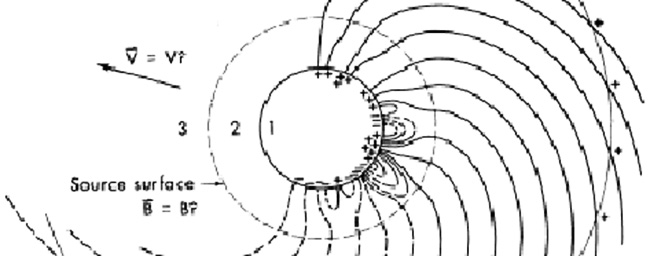
Above: The heliospheric magnetic fields.
Notice the field lines go
out as positive and loop back
in as the opposite polarity, and the
reverse happens
at the opposite pole.
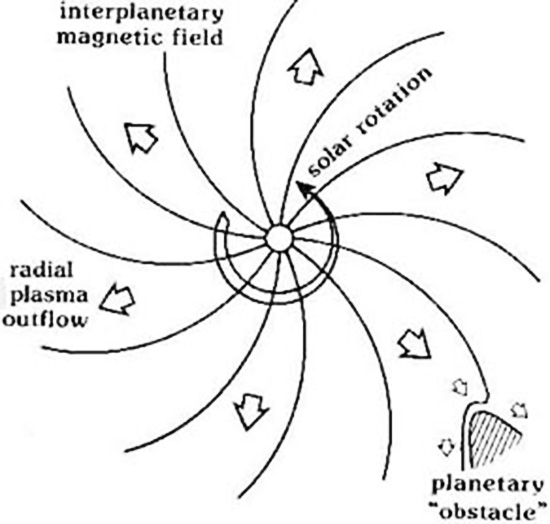
Right: Solar wind direction
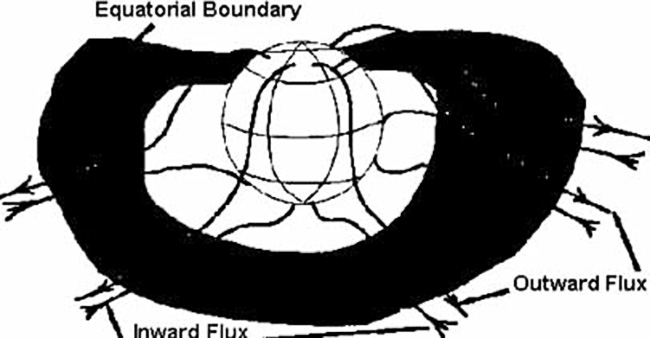
Left:
Boundary of the magnetic field showing
a current sheet separating
the magnetic field polarity.
The magnetic lines are marked with
the
outgoing and ingoing directions
Open magnetic field lines (those not curving back to the sun) spread
out like spokes of a wheel. Field lines take up the spiral pattern
of the particle stream (solar wind).
Although field lines wave about
in a chaotic way, they follow the expected spiral pattern when
averaged out over a longer period.
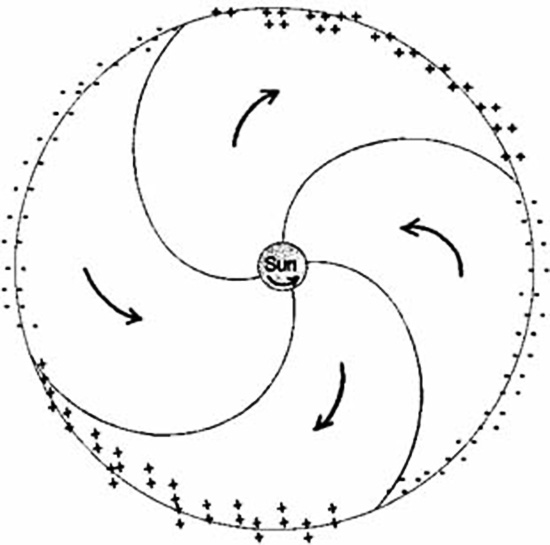
General Structure of the Interplanetary Magnetic Field.
The
different polarities of the sectors and their direction
caused by
the patches of alternating averaged polarity areas
are shown around
the equatorial region that cause
the undulations that appear like a
turning ballerina's dress.
Below shows these patches (usually 4 or
5)
along the sun's equator
The dots on a
magnetogram indicate that the sun's field is scattered over the
surface with apparently random polarity.
When these are averaged,
patches
or sectors of alternate polarity are distinguished. Sectors are
rooted in large scale regions of the photosphere, which have a net
single polarity.
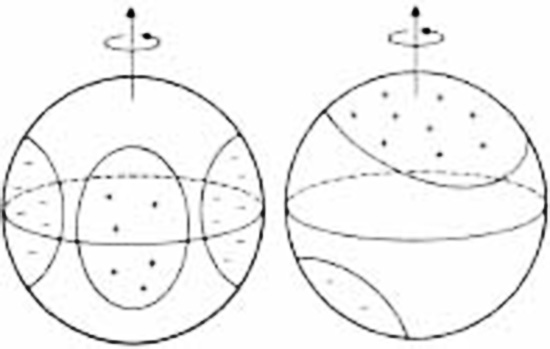
Near the equator the field is found to be divided into 2 to 4
sectors of alternate polarity.
The sectors are rooted in large scale
regions of the photosphere, which have a net single polarity. The
interplanetary field mirrors these sector polarities.
The simple pattern [of a dipole field with magnetic field lines
closed at the equator and opening emerging at higher altitudes,
bending over equatorial loops, and extending radially above and
below a neutral sheet at the magnetic equator] is disturbed by
sectors of net single polarity in the photosphere which warp the
neutral sheet.
Instead of following a straight line along thee
equator the neutral line at the solar surface waves to and fro
across the equator in a very rough sinusoidal form between the +/-
40 deg. latitudes.
The pattern extends outward to produce the warped neutral sheet in
interplanetary space.
As the sun rotates, the warped boundary passes
the earth at regular intervals giving an earth based impression of
sectors of opposite magnetic polarity (depending on whether the
neutral sheet passes above or below the earth.
Solar wind speed is low over any neutral line or sector boundary,
and attains high speed away from such a boundary. If warps are
great, a high speed stream will be observed when each sector passes
by. These sectors are often filled by a coronal hole.
Since large
coronal holes are usually present at each pole, it may be that a
major part of the solar wind flows from these holes.
Differential Rotation
The sun's
photosphere rotates faster at the equator than the poles.
This is
called differential rotation...
Although the earth doesn't have
differential rotation, the wind and ocean currents in Earth's
weather systems are similar and are said to be caused by a
combination of the Earth's rotation and convection resulting in
alternate bands.
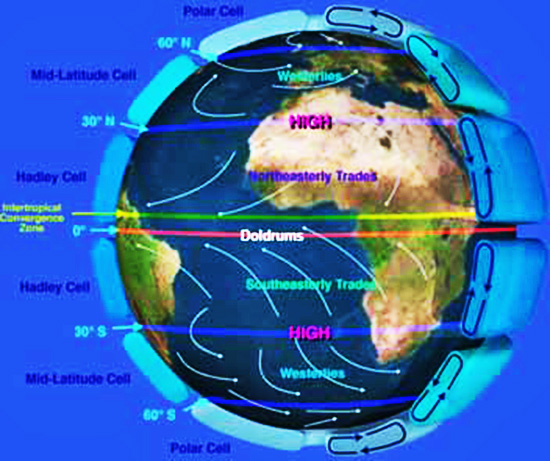
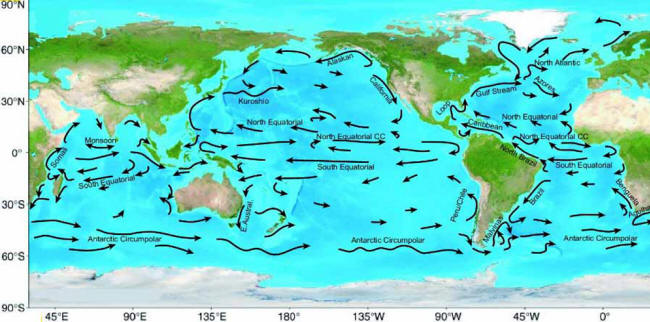
The Glow Discharge Model of the Sun
The
Electric model
of the Sun is not too different from the gravitational model.
Most
of the underlying assumptions are preserved: an isolated body at
equilibrium; a point force distributed spherically (decreasing with
the square of the distance from the point); conditions of isotropy,
continuity and homogeneity.
If the sun is likened to a ball, if positively charged, it will
repel positive ions, generating a "wind" that accelerates away from
the ball, much as is observed with the solar "wind." And the ball
will attract electrons.
Because they are so much less massive than
ions, they could be accelerated to relativistic velocities. With
sufficient velocity, their collision with the ball could account for
its luminosity.
But spacecraft have not found any relativistic electrons. And the
solar wind seems to be composed of nearly equal numbers of positive
ions and negative electrons. And the ions practically stop
accelerating by the time they reach the orbit of the Earth.
And most
of the solar wind is confined to the Sun's equatorial plane.
The Electric Universe model is based on electrodynamics. Bodies
immersed in plasma aren't isolated; they are connected by circuits.
They often aren't at equilibrium; most astronomical bodies are
radiating energy because they are in unstable conditions and are
moving toward equilibrium.
Currents in plasma contract into linear
filaments; and the force between filaments decreases linearly with
distance, which makes it the most powerful long-range force in the
universe.
Plasma divides into cells that are separated by
capacitor-like double layers; and this ensures that plasma phenomena
are characterized by conditions of non-isotropy, discontinuity and inhomogeneity.
In an electric universe a cellular sheath or "double layer"
separates the plasma cell that surrounds the Sun ("heliosphere")
from the enveloping galactic plasma.
Almost the entire voltage
difference between the Sun and its galactic environment occurs
across the thin boundary sheath of the heliopause. Inside the
heliopause there is a weak but constant radial electrical field
centered on the Sun.
A weak electric field, immeasurable locally but
cumulative across the vast volume of space within the heliosphere,
is sufficient to power the solar discharge.
The visible component of a coronal glow discharge occurs above the
anode, often in layers. The Sun's red chromosphere is part of this
discharge. Correspondingly, the highest particle energies are not at
the photosphere but above it.
Blasts of particles escape the Sun at an estimated 400- to
700-kilometers per second. A weak electric field, focused on the
Sun, better explains the acceleration of the charged particles of
the solar wind.
Electric fields accelerate charged particles.
And
just as magnetic fields testify to the presence of electric
currents, particle acceleration is a good measure of the strength of
an electric field.
Critics assume that the radial electric field of the Sun should be
measurable and also strong enough to accelerate electrons toward the
Sun at "relativistic" speeds (up to 300,000 km per second).
But in the plasma glow-discharge model the interplanetary electric
field will be extremely weak.
No instrument placed in space could
measure the radial voltage differential across a few tens of meters,
any more than it could measure the solar wind acceleration over a
few tens of meters.
But we can observe the solar wind acceleration
over tens of millions of kilometers, confirming that the electric
field of the Sun, though imperceptible in terms of volts per meter,
is sufficient to sustain a powerful drift current across
interplanetary space.
Given the massive volume of this space, the
implied current is quite sufficient to power the Sun.
C.E.R. Bruce
proposed in 1944 that the Sun's,
"photosphere has the appearance,
temperature and spectrum of an electric arc; it has arc
characteristics because it is an electric arc, or a large number of
arcs in parallel."
This discharge
characteristic, he claimed,
"accounts for the observed
granulation of the solar surface."
The following
Oahspe passage suggests these "arcs in parallel", or
that which are viewed from earth telescopes as granulations, are
like the "great lights" (Borealis) at the earth's magnetic poles,
but acting "all around".
1.23. In the
beginning of the earth's vortex, the current concentrated into its
center, certain substances, where, by friction, the vortexya
manifested in heat, so that when the congregation of materials of
the earth's substance were together, they were as a molten mass of
fire.
1.24. And for a long period of time after the fire disappeared, two
great lights manifested, one at the
north and one at the south.
1.25. Were the earth a central planet, like the sun, the light would
have been all around, in which case it
would have been called a photosphere.
1.26. By vortexya the earth was first formed as a ball of fire. By
the same power (vortexya) the warmth of the surface of the earth is
manufactured to this day.
Cosmogony and Prophecy Ch1
[When a body
rotates while subject to
tidal forces,
internal friction results in the gradual dissipation of its
rotational kinetic energy as heat.
If the body is close enough to
its primary, this can result in a rotation which is tidally locked
to the orbital motion, as in the case of the Earth's moon.
Tidal
heating produces dramatic volcanic effects on Jupiter's moon Io.
Io is the most geologically active object in the Solar System.
Unlike the Earth and the Moon, Io's main source of internal heat
comes from tidal heating rather than radioactive isotope decay. Such
heating is dependent on Io's distance from Jupiter, its orbital
eccentricity, and composition.
Its Laplace resonant orbit with Europa and Ganymede maintains Io's
eccentricity and prevents tidal dissipation within Io from
circularizing its orbit. The resonant orbit also helps to maintain
Io's distance from Jupiter; otherwise tides raised on Jupiter would
cause Io to slowly spiral outward from its parent planet.
The vertical differences in Io's tidal bulge, between the times Io
is at its periapsis and apoapsis points along its orbit, could be as
much as 100 m (330 ft).
The friction or
tidal dissipation produced in Io's interior due to this varying
tidal pull, which, without the resonant orbit, would have gone into
circularizing Io's orbit instead, creates significant tidal heating
within Io's interior, melting a significant amount of the moon's
mantle and core.
The amount of energy produced is up to 200 times
greater than that produced solely from radioactive decay. This heat
is released in the form of volcanic activity, generating its
observed high heat flow.
Currently science treats 'tidal heating',
magnetism and 'radioactive
isotope decay' as separate unrelated causes.]
The difference with
the case of the earth would be that while the earth's entry point
for vortexya would be only from the east and west [I assume],
creating north and south poles, the sun's entry points come radially
down to the spherical sun as rain falling towards the earth, and all
around, simultaneously.
In this case the sun is like a heliospheric
anode acting like a focus for negative charge from all directions of
the heliosphere, so creating, collectively, a
coronal
glow discharge or 'anode glow', which becomes the bright
photosphere, as has been hypothosized as follows:
In 1972, Juergens
suggested that the Sun is not an electrically isolated body in
space, but the most positively charged object in the solar system,
the center of a radial electric field lying within a larger galactic
field, hypothesising an external power source of the Sun.
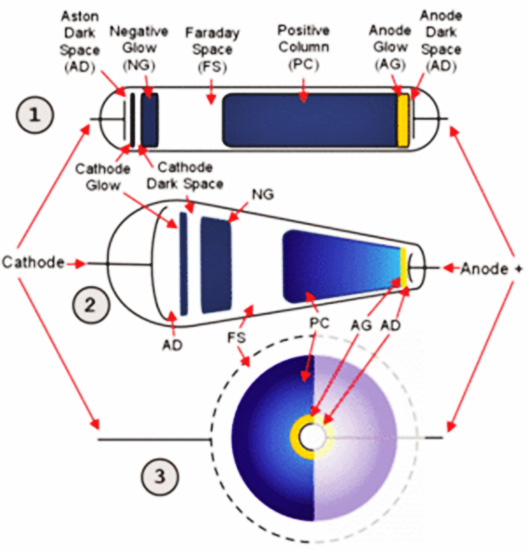
Glow discharge tubes
and their characteristics:
1. Cylindrical
2.
"funnel-shaped" 3. Spherical
Juergens felt that
a glow discharge tube, in particular the anode and 'anode glow',
shared characteristics with the Sun (the anode) and its atmosphere
(the anode glow).
Also, that the Sun's,
"granules might be akin to
certain highly luminous tufts of discharge plasma variously
described as anode glows, anode tufts, and anode arcs".
Irving Lanmuir described anode glows as plasma sheaths:
"as we decrease the size of an anode in a tube the sheath breaks
down and an anode glow appears usually in the form of a sharply
defined globular or semispherical region several times more highly
luminous that the surrounding region."
"With anodes of small size compared to the tube diameter strong
ionization occurs and the anode sheath breaks down. A ball or
sharply defined region of intense glow thus appears on the anode"
Physicist Wal
Thornhill has noted that an extended positive column has similarities
to interplanetary space.
Electrical engineer
J.D. Cobine writes
that,
"The positive column is a region of almost equal
concentrations of positive ions and electrons and is characterized
by a very low voltage gradient".
The positive column also features a weak radial electric field which
may explain the anomalous deceleration of the Pioneer spacecraft.
Juergens proposed
that the Sun is the focus of a "coronal glow discharge" fed by
galactic currents. Throughout most of the volume of a glow discharge
the plasma is nearly neutral, with almost equal numbers of protons
and electrons.
The charge differential at the Earth's distance from
the Sun is smaller than our present ability to measure - perhaps one
or two electrons per cubic meter.
But the charge density is far
higher closer to the Sun, and at the solar corona and surface, the
electric field is of sufficient strength to generate all of the
energetic phenomena we observe.
Closer looks at the Sun have revealed the pervasive influence of
magnetic fields, which are the effect of electric currents.
Sunspots, prominences, coronal mass ejections, and other features
imply an anode in a coronal glow discharge
behavior.
The Sun is the anode or positively charged body in the
electrical exchange, while the negatively charged contributor is the
invisible "virtual cathode" at the limit of the Sun's coronal
discharge, just as coronal discharges are sometimes seen as a glow
surrounding high-voltage transmission wires, where the wire
discharges into the surrounding air.
A corona discharge
is an electrical discharge brought on by the ionization of a fluid
surrounding a conductor, which occurs when the potential gradient
(the strength of the electric field) exceeds a certain value, but
conditions are insufficient to cause complete electrical breakdown
or arcing.
A corona develops when a sustained current from an electrode with a
high potential in a neutral fluid, usually air, ionizes that fluid
so as to create a plasma around the electrode.
When the potential
gradient is large enough at a point in the fluid, the fluid at that
point ionizes and it becomes conductive.
If a charged object has a sharp point, the air around that point
will be at a much higher gradient than elsewhere. Air near the
electrode can become ionized (partially conductive), while regions
more distant do not.
When the air near the point becomes conductive,
it has the effect of increasing the apparent size of the conductor.
Since the new conductive region is less sharp, the ionization may
not extend past this local region.
Outside of this region of
ionization and conductivity, the charged particles slowly find their
way to an oppositely charged object and are neutralized.
If the geometry and gradient are such that the ionized region
continues to grow instead of stopping at a certain radius, a
completely conductive path may be formed, resulting in a momentary
spark, or a continuous arc.
Corona discharge usually involves two asymmetric electrodes; one
highly curved (such as the tip of a needle, or a small diameter
wire) and one of low curvature (such as a plate, or the ground).
The
high curvature ensures a high potential gradient around one
electrode, for the generation of a plasma.
Coronas may be positive or negative. This is determined by the
polarity of the voltage on the highly-curved electrode. The physics
of positive and negative coronas are strikingly different.
This
asymmetry is a result of the great difference in mass between
electrons and positively charged ions, with only the electron having
the ability to undergo a significant degree of ionizing inelastic
collision at common temperatures and pressures. An important reason
for considering coronas is the production of ozone around conductors
undergoing corona processes.
A negative corona generates much more
ozone than the corresponding positive corona.
Applications of corona discharge include improving wetability or
'surface tension energy' of polymer films to improve compatibility
with adhesives. Kirlian photography uses photons produced by the
discharge to expose photographic film.
An electrical discharge (a
spark) splits an oxygen molecule into two oxygen atoms. (Electrical
discharge is also referred to as corona discharge.) These unstable
oxygen atoms combine with other oxygen molecules.
This combination
forms ozone.
Any separation of
charge in space is quickly neutralized as electrons rush to
neutralize the charge imbalance. As a result, electricity in space
is almost never mentioned, except as a transient effect.
It is
always assumed that there is a source of electrons to meet any
deficiency and that they can be supplied faster than the charging
process. However, space is a far better vacuum than any we can
achieve on Earth, so the assumption that there are sufficient
electrons available may not be true.
And where there are sufficient
electrons, in their rush to neutralize the electric field they may
undergo the magnetic "Z pinch" effect that cuts off the current at
some maximum value before recovering and beginning the cycle once
more.
Observations of energetic activity in space on all scales show
this kind of "bursty" behavior. An example was a mysterious X-ray
'hot spot' that flares up like a beacon every 45 minutes at Jupiter.
In our
electric universe the forces between charged objects is of
the same form as Newton's equation, with charge replacing mass.
The
BIG difference is that the electrical force is about 1039 times
stronger than gravity. An electric field in space can give rise to
electric discharge phenomena like those seen in a low-pressure gas.
Examples are the neon tube and the aurora.
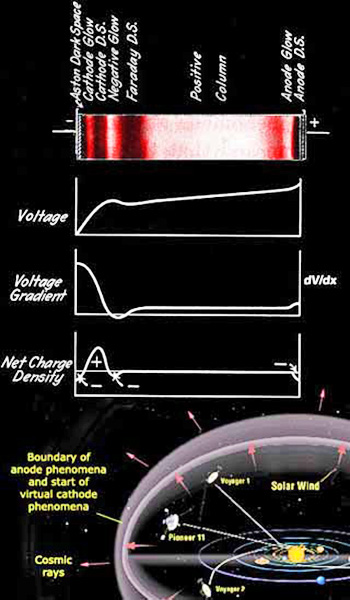
Diagram from Gaseous Conductors [D.S. = dark space]
This is a diagram showing
a discharge tube with all of the important features annotated above
the tube.
In the Sun’s huge
environment, the only bright regions are very close to the Sun
because the energy density is too low to excite a glow. Below the
tube are graphs showing the variation of important variables along
the tube length. The discharge tube demonstrates complexity of
electric discharges in near vacuum.
Within our solar system the Sun bears all of the hallmarks of a
small spherical anode in a galactic discharge. The planets occupy a
vast region within the heliosphere, known in gas discharge theory as
the positive column, which has a weak electric field centered on the
Sun.
Unlike the thin neon
tube, the Sun occupies a vast sphere more than 16 billion miles
across, so the positive column disappears and the current is carried
throughout that volume by a low density of ionization. It requires
only that the Sun’s electric field has sufficient strength to cause
a drift of electrons toward the Sun, superimposed on their random
thermal motion. In other words, it is immeasurably small.
The net charge density in
the positive column is zero, that is, there are an equal number of
negative and positive charges in interplanetary space.
The regions of high electric field are close to the anode and
cathode.
In the Sun’s case, being
the anode, it is in the corona, where electrons are accelerated
toward the Sun, causing the apparent million-degree temperatures
there, and the protons are accelerated away from the Sun–to form the
solar wind. Positive particles in the solar wind continue accelerate
beyond the orbits of Mercury and Venus.
The cool photosphere
beneath a “hot” corona is, for the first time, understandable if the
Sun’s energy is delivered externally.
The Sun does not have an identifiable cathode in space like the
metal cathode in the glow discharge tube. Instead, the plasma in
space forms a bubble, a 'virtual cathode', which is the heliopause.
In plasma terms it is not
a result of mechanical shock but is a Langmuir plasma sheath that
forms between two plasmas of different charge densities and
energies.
In this case it forms the
boundary between the Sun’s plasma and that of the galaxy. Such
“bubbles” are seen at all scales, from the comas of comets to the
‘magnetospheres’ of planets and stars.
They show that the
central body is electrically charged relative to its surroundings.
And there floated
within etherea certain types of densities, called ji‘ay, a‘ji,
and nebula, which sometimes augmented the size of the traveling
corporeal worlds, and sometimes illumed them on the borders of
the vortices, and these corporeal worlds were called
photospheres, because they were the places of the generation of
light.
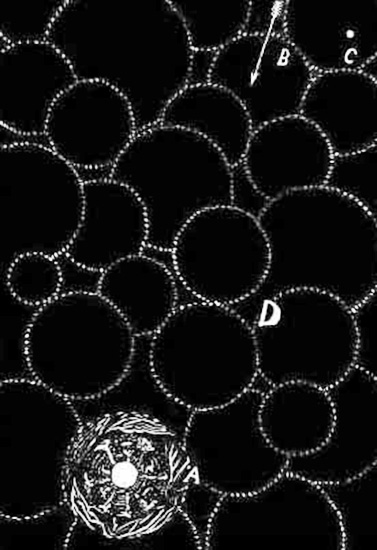
Oahspe Image: Photospheres.
D
is etherea and the etherean worlds in dotted outline;
A is a
photosphere, ie., a corporeal sun as it moves
through etherea and
the etherean worlds;
B, the direction of the solar phalanx
(photosphere plus planets)
through etherea; and C, a corporeal
planet (eg., the earth) being carried
in the master vortex of the
solar system.
This description
correlates to the above EU statement about magnetospheres,
suggesting that a sun is a bubble of rarified atmospherean/corporeal
material (heliosphere) consisting of three densities, floating in a
much more rarefied 'etheria'.
These inhomogeneous bubbles or cells
have a skin, a plasma sheath, or double layer, which are regions of
greater density of cosmic dust and plasma, that, because of their
lumpiness, develop charge separation.
Of the atmospherean substances
ji'ay is more rarefied, a'ji is comparatively thicker and nebula
(which includes comets) is thickly dense.
3.3 ... As you
see the power of the whirlwind gathering up the dust of the earth,
and driving it together, know that likewise I bring together the
ji'ay, a'ji and nebulae in the
firmament of heaven; by the power of the whirlwind I create the
corporeal suns, moons and stars. And man named the whirlwinds
according to their shape, calling them vortices and wark ...
6.5. These that you saw are the ji'ay, the a'ji, and the nebulae;
and amid them, in places, there is se'mu also. Let no man say: Over
there is hydrogen only, and over here, oxygen only. All the elements
are to be found not only in places close by, but in distant places
also.
04/6.6. When the Father drives forth His worlds in the heavens, they
gather a sufficiency of all things. And when a corporeal world is
yet new and young it is carried forth not by random, but purposely,
in the regions suited to it. Accordingly, as there is a time for
se'mu; and a time for falling nebulae to bury deep the forests and
se'muan beds, to provide coal and manure for a time afterward; so is
there a time when the earth passes a region in the firmament when
sand and oil are rained upon it, then covered up, and gases bound
and sealed for the coming generations of men.
Book of Jehovih
After launch, a
spacecraft accepts electrons from the surrounding space plasma until
the craft's voltage is sufficient to repel further electrons.
Near
Earth it is known that a spacecraft may attain a negative potential
of several tens of thousands of volts relative to its surroundings.
So, in interplanetary space, the spacecraft becomes a charged object
moving in the Sun's weak electric field. Being negatively charged,
it will experience an infinitesimal "tug" toward the positively
charged Sun.
Of most significance is the fact that the
voltage gradient, that is the
electric field, throughout
interplanetary space remains constant.
In other words, the retarding
force on the spacecraft will not diminish with distance from the
Sun. This effect distinguishes the electrical model from all others
because all known force laws diminish with distance.
The electrical
model predicts that additional anomalies will be found when a
spacecraft encounters the heliopause. Pioneer 10 is now 7.4 billion
miles from Earth, maybe 90 percent of the way to the heliopause. The
heliopause is the "cathode drop" region of the Sun's electrical
influence.
It is a region of strong radial electric field, which
will tend to decelerate the spacecraft more strongly.
Almost the
full difference between the Sun's voltage and that of the local arm
of the galaxy is present across the heliopause boundary. As a
result, it is the region where so-called "anomalous" cosmic rays are
generated by the strong field.
Spiral arms of a galaxy must carry the electric current that lights
the stars. The force between parallel currents varies inversely with
distance, instead of the much more rapid fall-off of gravity with
the square of the distance.
The result is that the longest-range
force law in the universe governs galactic motions, and short-range
repulsion maintains the integrity of the spiral arms.
A star is a
pinpoint object at the center of a vast plasma sheath.
The plasma
sheath forms the boundary of the electrical influence of the star,
where it meets the electrical environment of the galaxy. In the
immense volume of the heliosphere an unmeasurably small drift of
electrons toward the Sun and ions away from the Sun (the
solar wind) can satisfy the electrical
power required to light the Sun.
It is only when we get very close
to the Sun that the current density becomes appreciable and plasma
discharge effects become visible.
The enigma of the Sun's
millions-of-degrees corona above a relatively cold photosphere is
solved when the Sun's power comes from the galaxy and not the center
of the Sun.
It is clear from the behavior of its relatively cool photosphere
that the Sun is an anode, or positively charged electrode, in a
galactic discharge.
The red chromosphere is the counterpart to the
glow above the anode surface in a discharge tube. When the current
density is too high for the anode surface to accommodate, a bright
secondary plasma forms within the primary plasma.
It is termed "anode tufting."
On the Sun, the tufts are packed together tightly
so that their tops give the appearance of "granulation."
The modern belief is that the granules are,
"the changing tops of
convection currents bringing light and heat from an unstable layer
beneath. The enormous flood of radiant energy generated within the
sun pours forth at last into space".
A granule may be viewed as a relatively dense, highly luminous,
secondary plasma that springs into being in the embrace of a
thinner, less luminous, primary plasma.
The electric-sun hypothesis assigns the sun the role of anode (the
higher-potential electrode) in a cosmical electric discharge.
The
term anode glow is applied to the formation of a continuous, glowing
"skin" or "film" of plasma-like sheathing on an anode surface. There
are similarities between anode tufts and photospheric granules.
Anode tufts appear at localized points of electric breakdown in an
anode sheath. When the electric current to the anode becomes
excessive, breakdown - further ionization of the medium - takes
place, and "a second plasma will form within the first".
To follow Langmuir's argument, we must first recall that the
particles of matter in a discharge plasma have two kinds of motion.
First are the random (thermal) motions reflected in the
"temperatures" of the several populations of particles: electrons,
positive ions and electrically neutral atoms and molecules.
Typically, electrons, the least massive of all these particles, have
the highest random velocities.
In addition to the thermal motions, and superimposed upon them,
there are drift motions among the electrically charged particles in
response to weak electric fields that pervade the plasma regions of
any electric discharge.
The electrons "sense" these electric fields
of the discharge and tend to drift toward the anode.
Positive ions
tend to drift in the opposite direction, away from the anode and
toward the cathode. This combined drift of negative charges in one
direction and positive charges in the other direction constitutes a
drift current - the entire electric
current of the discharge through the plasma.
To maintain a steady discharge, the anode must collect an
uninterrupted stream of electrons whose electric current, or flow of
charge per unit time, equals the total drift current in the full
cross section of the discharge plasma.
(The discharge
"cross-section" may be thought of as a closed, spherical surface in
space, outside the Sun at some distance beyond the reach of "anode"
phenomena; say, arbitrarily, at perhaps a few solar radii from the
photosphere.)
Now, the random motions of the plasma electrons are usually much
more energetic (faster) than their drift motions. In any case, they
complicate matters for an anode bent on maintaining a stable
discharge.
Suppose, for example, that the area of the anode surface equaled
the plasma cross-section. (For the Sun, this would mean that the
interplanetary plasma extended all the way to the solar "surface".)
If the anode were in direct contact with the plasma, it would tend
to receive not only the electron drift current but also a random
current delivered by those electrons whose thermal motions within
the plasma happened to be toward the anode at a given instant.
With
the electron random current exceeding the drift-current component
due to the positive ions (moving in the opposite direction), the
total current collected by the anode would be more than the
discharge could sustain, and an instability would result. (This
suggests, perhaps, one possible explanation for the highly variable
behavior of certain stars.)
The remedy is for the anode to disengage
itself from the plasma. Initially, it accepts a certain number of
excess electrons and takes on a slightly negative charge (relative
to the plasma) - a slightly lower relative potential - which repels
all but the most energetic of the electrons approaching thereafter.
The anode adjusts its potential to a value that permits the further
arrival of only enough electrons to deliver a current equaling that
carried by the discharge plasma.
Rejected electrons return to the
plasma, leaving behind a thin sheath of positive space charge - a
region "overpopulated" by positive ions - between the plasma and the
anode surface.
Due to this adjustment, the anode electric potential
is now somewhat lower than that of the plasma being held at bay.
The
region that Langmuir named the sheath bridges the distance between
anode and plasma, as well as the difference in potential between
them. The sheath thus "contains" (limits) the electric field due to
the excess negative charge on the anode.
In other words, the
positive space charge of the sheath counterbalances the excess
negative charge taken on by the anode in making its adjustment.
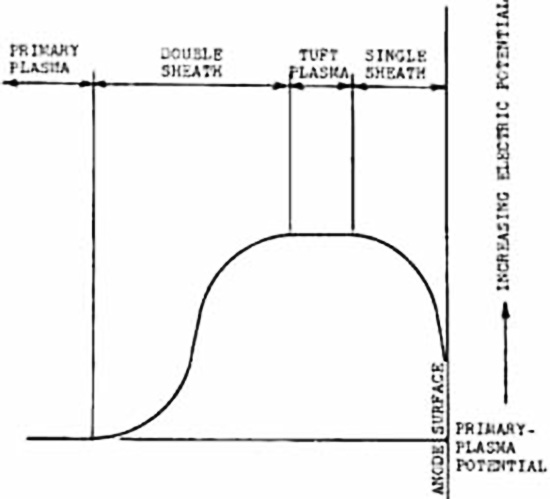
Potential-Distribution
from a point within the primary plasma,
across the secondary plasma of the tuft,
to the anode surface
W.P. Allis has
described the tufting process as raising the anode potential with
respect to the primary plasma, thus increasing the discharge current
while keeping the anode surface area constant.
As the anode
potential is raised past the excitation level of the gas, the
electrons approaching the anode have enough energy to excite the
gas, and a sheath of anode glow forms. Then as the current is raised
still further the anode voltage suddenly drops.
It decreases while
the current increases, and a tufted anode is formed.
"A tufted anode is one on which bright spots appear just above the
anode surface. As the current is increased or decreased, the number
of tufts also increases or decreases. The tufts always appear to
arrange themselves symmetrically.
In the sheath that separates the primary and secondary plasmas, the
voltage- (potential-) distribution curve is bent like a letter "S".
An inflected curve of this kind in a potential-distribution diagram
is the unmistakable mark of the double sheath.
Next to the lower
potential (primary) plasma, in the region where the curve is concave
upward, is a sheath of negative space charge.
Between this and the
higher-potential (secondary) plasma of the tuft, in the region where
the curve is concave downward, is a sheath of positive space charge.
Thus there are two sheaths, in a sense, back-to-back.
Together they
provide a smooth transition between the differing electric
potentials of the two plasma regions.
Stars with a
thermonuclear core are not likely to be stable
The tufted plasma sheath above the stellar anode seems to be the
cosmic equivalent of a 'PNP transistor,' a simple electronic device
using small changes in voltage to control large changes in
electrical power output.
The tufted sheath thus regulates the solar
discharge and provides stability of radiated heat and light output,
while the power to the Sun varies throughout the sunspot cycle.
The Sun is a variable X-ray star; it is fortunate for us that the
variability is not reflected in the energy flux in the visible. We
rely on the Sun to shine steadily. The variation in light and heat
is measured to be a fraction of one percent from year to year.
Yet
the Sun is a variable star when viewed in X-rays.
And X-rays are
emitted where electrical activity is most intense.
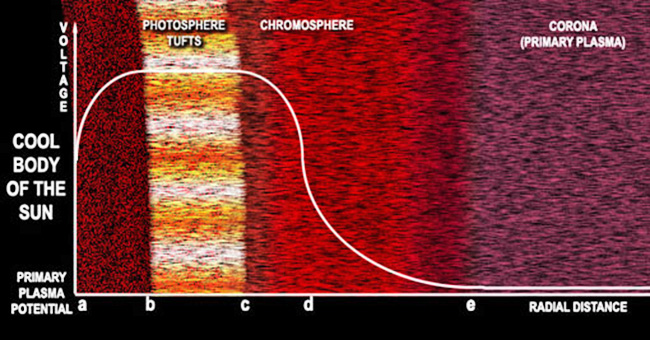
Sun's plasma sheath.
The white curve (right) shows how the voltage
changes
within the solar plasma as we move outward from the body of
the Sun.
Positively charged protons will tend to "roll down the
hills."
So the photospheric tuft plasma acts as a barrier to limit
the Sun's power output.
The plateau between (b) and (c) and beyond
(e) defines a normal quasi-neutral plasma.
The chromosphere has a
strong electric field which flattens out
but remains non-zero
throughout the solar system.
As protons accelerate down the chromospheric slope, heading to the right,
they encounter turbulence
at (e),
which heats the solar corona to millions of degrees.
The
small, but relatively constant, accelerating voltage gradient
beyond
the corona is responsible for accelerating
the solar wind away from
the Sun.
This ability of the
Sun's plasma sheath to modulate the solar current was demonstrated
dramatically in May 1999, when the solar wind stopped for two days.
The bizarre event makes no sense if the solar wind is being
'boiled
off' by the hot solar corona. But in electrical terms, its
regulating plasma sheath performed normally and there was no
noticeable change in the Sun's radiant output.
Sunspots are a
phenomenon that is not expected in the standard thermonuclear model
of stars.
"The very existence of sunspots is intriguing. They should
be heated quickly from the sides and disappear. They should never
have formed - but they do form."
Sunspots are a clearing of the tufts where a dark discharge from an
equatorial plasma toroid encircling the Sun punches through them.
The dark center, or umbra, of the sunspot shows the cooler
temperature of the Sun beneath the bright plasma.
The sunspot
penumbra, in which we are looking at the sides of the "hole" punched
through the tuft layer, shows the structure of the tufts.
They are
bright tornadic cylinders of plasma, thousands of kilometers long.
Tornadoes are constrained by strong
electromagnetic forces to be a slow form of
lightning discharge.
This explains why solar granulations
last for about 10 minutes before slowly fading to be replaced by
others.
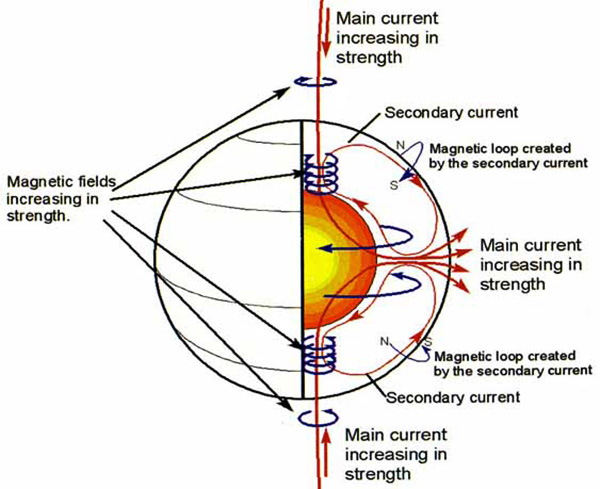
Primary and secondary
electric
currents in the Sun
If the main
magnetic field that induces the surface currents is growing in
strength, the surface current will point in one direction.
If the
main magnetic field weakens, the secondary surface currents will
reverse direction.
Stars are like neon
lights, gas discharge lamps and arc lights. The difference between
these types of lights are the power density of the discharge and the
location in the gas discharge path where most of the light comes
from.
For example, in a neon tube the light comes from the extensive
plasma column between the electrodes at
each end of the tube. In an arc light, the light is concentrated at
the electrode. As the power of an arc light is increased its color
changes from yellow-white to white to blue-white.
he sharp
discontinuities in the nature of the light from an electric
discharge as it switches from a red glow to a bright arc explain
many of the mysteries of starlight.
Astronomers use the Herzsprung-Russell (H-R) diagram to categorize
stars.
It is a plot of the absolute brightness of stars against
their spectral class (temperature).
As you increase the current
density to an electric arc, the light becomes brighter, hotter, and
therefore bluer. In other words, the current density is responsible
for both the luminosity (y-axis) and the color temperature (x axis)
of the H-R diagram.
That explains the near 45°slope of the so-called
'main sequence' stars in the corrected H-R diagram (right).
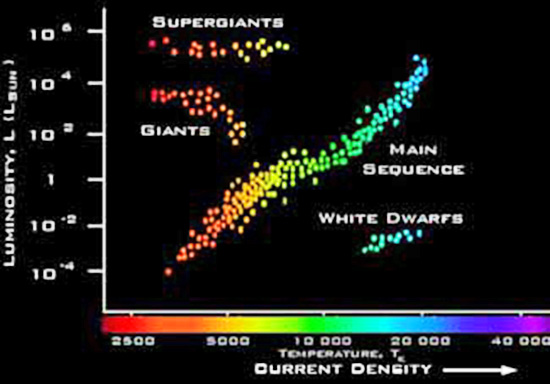
Herzsprung-Russell (H-R) diagram reversed,
and showing current
density increase.
At the lower
left-hand end of the main sequence, where the current density has
such a low value that double layers (photospheric granules) are not
needed by the plasma surrounding the (anode) star, we find the red
dwarfs - small stars under low electrical stress, in which anode
tufting is sparse and the light from the tufts is emitted at low
energies, brown dwarfs and giant gas planets, toward the red end of
the spectrum.
Recent discoveries of extremely cool L-Type and T-Type dwarfs has required the original diagram to be extended to the
lower right. These 'stars' have extremely low absolute luminosity
and temperature.
The surface temperature of the T-Type dwarfs is
in the range of 1000 K or less!
T - Type spectra have features due
mostly to Methane - they resemble Jupiter's spectrum. For fusion
reactions to occur, standard theory requires that the temperature in
a star's core must reach at least three million K.
And because core
temperature rises with gravitational pressure, the star must have a
minimum mass of about 75 times the mass of the planet Jupiter, or
about 7 percent of the mass of our sun. Many of the dwarfs do not
meet these requirements.
The X-ray telescope, Chandra, recently
discovered an X-ray flare being emitted by a brown dwarf.
A star
this cool should not be capable of X-ray flare production.
A good deal of the red light comes from the chromospheric
anode glow
As we move diagonally upward and to the right on the H-R diagram the
stars become more massive and the current density increases.
Anode
tufting becomes more intense and the tufts' mutual repulsion forces
the photosphere to grow to accommodate them. At the top right of the
main sequence the light from the tufts is the electric blue of a
true arc and the stars appear as 'blue giants' - intensely hot
objects considerably larger than our Sun.
These
blue giants tend to be concentrated on the
central axes of our galaxy's spiral arm arms, where the
galactic currents are strongest.
Thermonuclear star models explain the discontinuities of red giants
and the white dwarfs as stars exploding, or else the transition off
the main sequence is said to be so rapid that we don't see a
continuous plot. In the electric star model, stellar color and
luminosity are discontinuous functions because plasma discharge
phenomena at an anode exhibit sharp discontinuities.
The terms 'giant' and
'dwarf,' when applied to these stars, are misleading
since a star's size is a plasma phenomenon too.
White dwarfs show a type of spectrum out of keeping with their
luminosity. A white dwarf is a star that is under low electrical
stress so that bright 'anode tufting' is not required.
The star
appears extremely hot, white and under-luminous because it is
equivalent to having the faint white corona discharge of the Sun
reach down to the star's atmosphere. A thin plasma sheath will be
formed between the plasma of the star and the plasma of space.
The
electric field across the plasma sheath is capable of accelerating
electrons to generate X-rays when they hit atoms in the atmosphere.
And the power dissipated is capable of raising the temperature of a
thin plasma layer to tens of thousands of degrees.
White dwarfs are often found in multiple star systems, which puzzles
astronomers because,
"it is not easy to understand how two stars of
the same age could be so different."
EU theory says the appearance
of stars has nothing to do with their age. In multiple star systems
the brighter primary star usurps most of the electrical power,
dissipating the energy in optical wavelengths.
The white dwarf
converts its share of power most efficiently into X-rays.
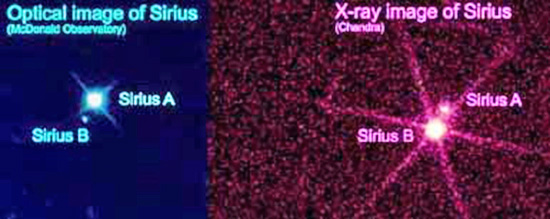
An example is the
nearby double
star system of Sirius, which is the brightest star in
the sky and one of the closest.
Sirius also has a partner called
Sirius B, a white dwarf. To our eyes, it is 10,000 times fainter
than the primary star, Sirius A.
However, when astronomers pointed
the Chandra X-ray telescope at Sirius, in the the X-ray image
(right), Sirius A was the lesser of the two lights. It is the
reverse of what we see with human eyes.
Red stars cannot satisfy their hunger for electrons from the
surrounding plasma. So the star expands the surface area over which
it collects electrons by growing a large plasma sheath that becomes
the effective anode in space.
The growth process is self-limiting
because, as the sheath expands, its electric field will grow
stronger.
Electrons caught up in the field are accelerated to
ever-greater energies. Before long, they become energetic enough to
excite neutral particles they chance to collide with, and the huge
sheath takes on a uniform 'red anode glow.' It becomes a red giant
star.
The electric field driving this process will also give rise to a
massive flow of positive ions away from the star, a prodigious
stellar wind. Indeed, such mass loss is a characteristic feature of
red giants.
Standard stellar theory is at a loss to explain this
since the star is said to be too 'cold' to 'boil off' a stellar
wind.
So when seen in electric terms, instead of being near the end
point of its life, a red giant may be a 'child' losing sufficient
mass and charge to begin the next phase of its existence - on the
main sequence.
Electric stars
offer radically new ideas about life on other worlds and the search
for extra-terrestrial intelligence.
A galactic source of electrical
energy provides more possibilities for sustaining life in the
universe than the lottery of finding an Earth-like planet orbiting
in a narrow 'habitable zone' about a bright star like the Sun.
The
probability of the latter occurrence is very low.
But with electric
stars, we can turn to the most numerous stars in the galaxy as
likely incubators of life - the brown 'dwarfs' - which are actually
red in color.
They could be
described as 'cosmic plasma eggs.'
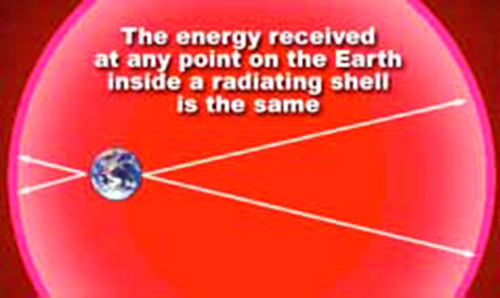
Imagine giant
Jupiter and its moons floating independently in deep space.
Outside
the Sun's dominating electrical influence, Jupiter would become a
dim electric star enclosed in the huge radiant red plasma shell of
its 'anode glow' - a brown dwarf.
Inside the glowing sheath is the
most hospitable environment in the universe for life because the
radiant energy received by each satellite is evenly distributed over
its entire surface.
There are no seasons, no tropics and no ice
caps.
2.6. In the ALL
HIGHEST places I created the etherean worlds, and I made them of all
shapes and sizes, similar to My corporeal worlds.
But I made the etherean worlds inhabitable both within and without, with entrances
and exits, in arches and curves, thousands of miles high and wide;
and in colors, movable chasms and mountains in endless change and
brilliancy; and over them I ruled with ALL PERFECT mechanism.
To
them I gave motions, orbits and courses of their own; and I made
them independent, and above all other worlds in potency and majesty.
Book of Jehovih
6.6. There is a
sun planet in the center of the photosphere, at a distance interior,
from three thousand miles to thirty thousand miles,1675 and it is
light all the way around.
Book of Cosmogony and Prophecy
The radiant energy
from the plasma cell of a brown dwarf star is strongest at the blue
and red ends of the spectrum.
Photosynthesis relies on red light.
L-type brown dwarfs have water as a dominant molecule in their
spectra, along with many other biologically important molecules and
elements. Satellites would accumulate atmospheres from the brown
dwarf and water would mist down.
Regardless of its spin and axial
tilt, a satellite orbiting inside the sheath of a brown dwarf could
experience an ideal environment for life.
The icy nature of the moons of our gas giant planets may be
electrically captured brown dwarf stars.
That would explain their
odd axial tilts, excess heat, and remnants of expulsion disks or
rings. But stars off the main sequence do not have the
self-regulating photospheric discharge to smooth out variations in
electrical power input.
Consequently, brown dwarfs are subject to
sudden outbursts, or 'flaring,' when they encounter a surge in the
circuit that powers them.
These flares could cause sparking to and
between the satellites orbiting inside the sheath and lead to sudden
extinction events, vast fallout deposits and fossilization.
The
problem for SETI is that no radio signals can penetrate the glowing
plasma shell of such a
brown dwarf star.
Intelligent life forms
living on the satellites of a brown dwarf star would be unaware of
the universe we witness.
| 





















